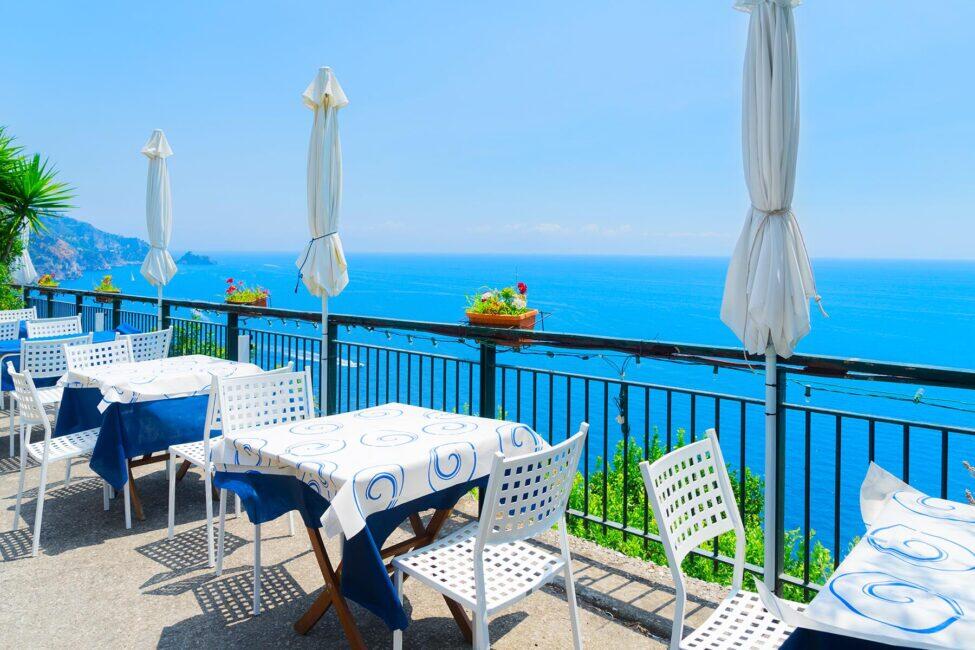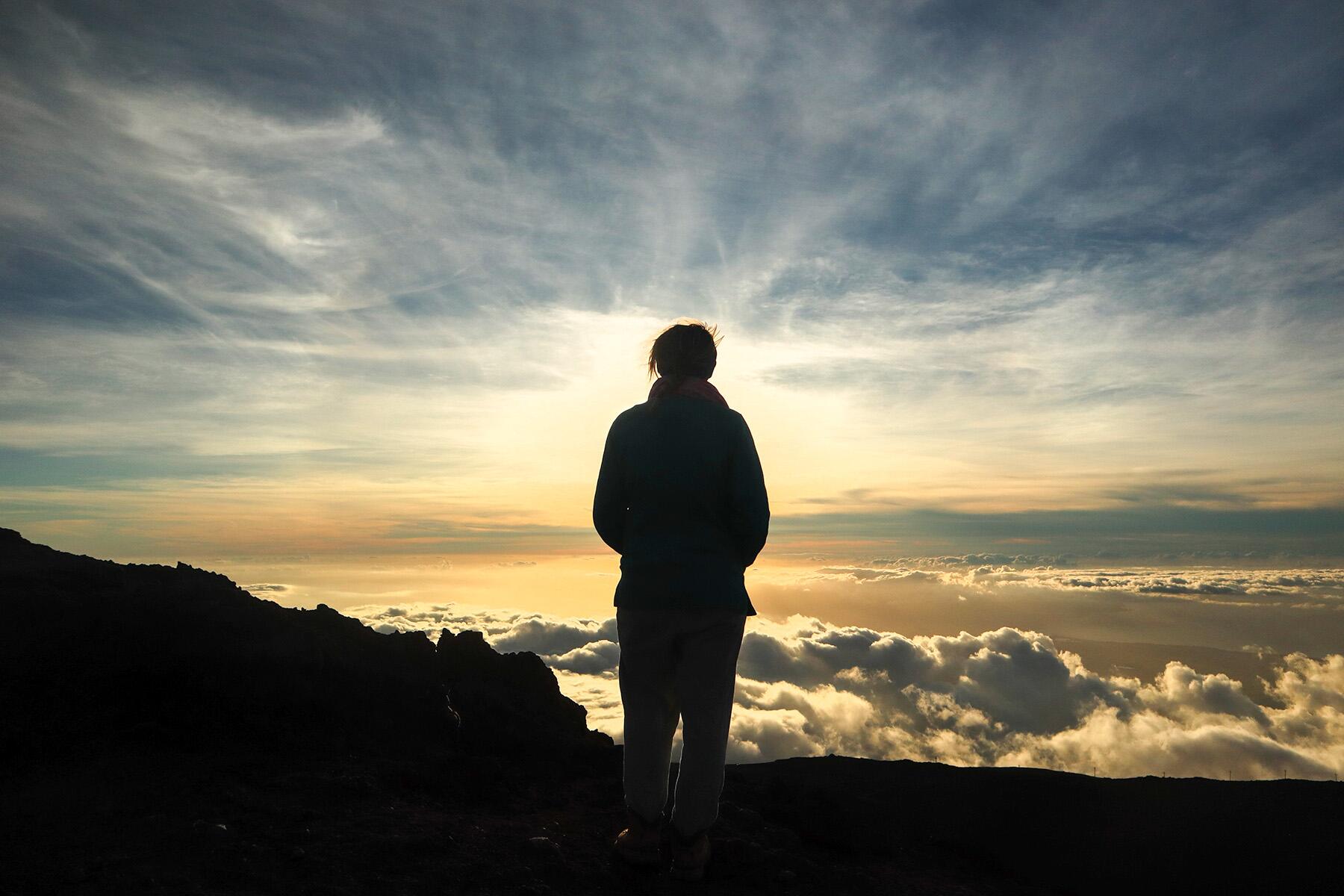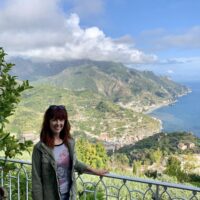I made them, so you don’t have to.
With its steep hillsides blanketed in lemon groves and its sweeping vistas of the Tyrrhenian Sea, the Amalfi Coast is the stuff of fantasy—for some visitors, a honeymoon destination; for others, a bucket-list trip. The charming, pastel-hued towns of this region of Campania are so idyllic that even the most seasoned traveler could be forgiven for thinking that you can’t go wrong when vacationing here.
But as I learned the hard way, you can go wrong regarding a few key aspects of the trip. I made these mistakes when visiting the Amalfi Coast, so you don’t have to.

Renting a Car
My husband and I value flexibility when we travel. We like to leave our local hotel or apartment when we want, go where we want, and make plenty of unplanned stops. And as lifelong Californians, we’re also used to driving treacherous roads like the winding 71-mile stretch of Highway One in Big Sur, which bears many similarities to Amalfi’s own coastal road. So, when we embarked on a trip to Rome, Naples, and the Amalfi Coast, we figured renting a car would be the best way to get around.
Big mistake.
After spending the first few days in Rome on foot, we picked up our car. Exiting the city was hard enough, and things only got worse from there. Descending into the maze-like, 2,000-year-old center of Naples felt like dropping off the high point of a roller-coaster—while simultaneously dodging Vespas, baby carriages, and the mad rush of humanity overflowing the sidewalks.
Recommended Fodor’s Video
Although the drive is one of the most picturesque in the world, there’s so much going on that it’s almost impossible to pay attention to the scenery, even for the most experienced drivers.
But then we got to the Amalfi Coast. Carved into the cliffs high above the ocean, the 25-mile stretch of state “highway” between Positano and Vietri sul Mare is much narrower and more serpentine than the Big Sur Coast Highway or any other road I’ve ever driven. It’s full of blind curves. It’s also horribly congested.
There’s very little in the way of shoulders or parking lots, so tourists wanting to take in the views often simply pull over, partially blocking one lane of the two-lane road. Traffic also backs up in front of tunnels while waiting for larger vehicles to squeeze through.
Although the drive is one of the most picturesque in the world, there’s so much going on that it’s almost impossible to pay attention to the scenery, even for the most experienced drivers.
Luckily, there are plenty of other options for getting around the Amalfi Coast. Despite our rental car mistake, we managed to take advantage of one of these options by finding a rare spot in a parking garage and temporarily giving up our car in favor of water taxis. These are humble, wooden boats with a motor attached, and they’re a lovely and affordable way to get from town to town. Sometimes they’re even manned by a friendly Italian fisherman who points out the sights along the way.
Other water transportation options include ferries and private boats. You could also take a bus or hire a private car, but of course, they get ensnared in the same traffic as everyone else. Some travelers choose to combine the best of both worlds by hiring a driver or taking a bus to get from Naples to Positano (or taking the train to Sorrento), then taking boats to get around the coast.
Since our visit, local authorities have instituted a traffic ban that can make driving on the coast even more fraught. Under the rules, which apply during the high season of mid-June through the end of September, rental cars with license plates ending in odd numbers can drive only on odd-numbered days. Those with license plates ending in even numbers are restricted to even-numbered days.

Spending Only One Night on Capri
Capri gets lots of love for its stunning scenery and luxury shopping. But much of that love is of the one-night-stand variety. Many tourists, like us, stay a single night; many more arrive by ferry in the morning and are gone by evening. For me, watching Capri recede into the distance as the sun’s last rays danced on the wake of our ferry felt like a heartbreak—as if I’d traveled halfway across the world and fallen in love at first sight, only to leave without ever having had the chance to get acquainted.
Sure, Capri is small, and its two main streets are lined with touristy gift shops, on one and high-end boutiques, on the other. But venture beyond these well-trodden areas, and you’ll understand why artists, writers, and celebrities alike have flocked to this island, some even abandoning all responsibilities back home to bask in its beauty forever. The trend began with the emperor Tiberius, who gave up on ruling Rome in the first century to live la dolce vita permanently on Capri.
Capri is known as l’isola dei sapori—the island of flavors—and these flavors deserve to be savored. Take a leisurely boat ride around the island (there are options for every budget), slow down to explore the famous Blue Grotto, or pass through the arches of Capri’s iconic faraglione. Swim in the most turquoise, emerald, and lapis water you’ve ever seen. Stroll along the cobblestone streets above the center of town, past multi-million-dollar villas, to take in the views from the Le Corbusier-designed Punta Tragara hotel. Or simply relax poolside, sipping an Aperol Spritz and surveying your seaside domain like an emperor. I’ve never heard of anyone who regretted spending more time in Capri.

Not Researching Where to Eat
It’s important to do your research before embarking on a big trip, but I’m of the opinion that not everything needs to be researched to death. Where to go, how to get there, important sights to see, yes. But cafes and restaurants, too? For some destinations, I think that’s overkill.
The Amalfi Coast is not one of those destinations. There are plenty of options for delicious cuisine on la costiera amalfitana, with its easy access to fresh fish and its rich, volcanic soil. However, the area is such a wildly popular tourist destination that it’s easy to end up in a less-than-stellar spot when searching for food on the fly. I made the unfortunate discovery during our trip that there is such a thing as so-so Italian pasta.
It’s my own fault for not planning ahead. As is the case in all areas heavily trafficked by tourists, some restaurants on the Amalfi Coast cater to the lowest common denominator, serving generic Italian dishes rather than regional or seasonal cuisine. And restaurants used to serving hundreds of tourists a day may not be able to put the same care into preparing food as those hidden away in alleyways frequented primarily by locals.
We managed to find some of those hidden gems, and they were amazing. We probably would have found even more if we’d researched and made a few reservations beforehand.

Not Understanding That in Family-run Restaurants, You’ll Be Treated Like…Family
When we did eat in the less touristy, family-run restaurants, the enticing aromas and delectable-looking dishes got the better of us, and we ordered more than we could finish. This provoked a response not unlike one you might get from your grandmother at a family dinner. On two occasions, we were chastised (teasingly, but nonetheless firmly) for failing to finish our food: once, by a server who hovered over our table until we began taking more bites; another time, by a nonna who emerged from the kitchen specifically to inform us that we shouldn’t have filled up on pizza when there were so many more exciting things on the menu. (I mean, fair.)
Like every culture, Italy has its own customs when it comes to dining out. Eat your pizza with a knife and fork. Be familiar with the typical Italian meal structure (antipasto, primo, secondo, contorno, dolce). Particularly in smaller, family-owned establishments, try not to order more than you can eat unless you want to risk offending the chef. And always listen to your nonna.
Splitting Your Stay Between Two or More Coastal Towns
Eager to immerse ourselves in more than one place, we split our time on the Amalfi Coast between Positano and Conca dei Marini, a tiny fishing village near Amalfi. In retrospect, having a single home base would have made more sense.
All of the towns on the coast are relatively close to one another and can be reached by water, except for the hilltop town of Ravello. So it’s easy to return to the same hotel or rental home every night. Choosing a single accommodation simplifies the trip—no need to pack and unpack multiple times; more time to relax and enjoy.
Not Spending More Time at the Beach
The beaches along the Amalfi Coast are different than the ones I’m used to in California: They tend to be small and narrow, and many are essentially rock outcroppings where you can rent lounge chairs. But the water is chef’s kiss, and the ambiance is delightful. We spent one of the best afternoons of our trip on a tiny, tucked-away beach at the base of what seemed like 500 stone steps, basking in the sun, swimming in the ocean, and feasting at a seafood restaurant said to have been frequented by Jackie Kennedy.
It’s impossible to do it all in any one trip, and sometimes there have to be trade-offs. Would we have traded our archeologist-guided tour of Pompeii (mind-blowing) for another day at the beach? Absolutely not. But in an ideal world, we would have spent a little extra time on the beaches to truly experience the Italian art of dolce far niente—the sweetness of doing nothing.
Not Learning a Bit More Italian
I believe that, as guests in a foreign country, it behooves international travelers to learn at least some simple phrases in the language of the country they’re visiting. It’s a matter of basic courtesy to be able to say things like “please,” “thank you,” “Good Morning,” “excuse me,” “How do I get to ____,” “I’d like ____,” and of course, “This is delicious!” Plus, it makes for a much more rewarding visit: You’re able to navigate beyond the confines of the major hotels and restaurants and connect with the country’s residents, who usually appreciate your efforts to understand an aspect of their culture.
So a couple of months before our trip, I set about learning some Italian on one of the many free language apps. I did learn the basic phrases and was excited when I was able to have a conversation in Italian (albeit brief and halting) with the guy at the corner café who made me an espresso on our first morning in Rome. But there were plenty of times when my limited Italian felt inadequate. Once I finished discussing food or exchanging pleasantries, I couldn’t say much.
Knowing more of the language would have allowed me to get to know Italy and the Italian people on a deeper level. Next time we go, I’ll be prepared—I’ve already been practicing by watching the exquisite Italian series My Brilliant Friend, based on the Neapolitan novels by Italian author Elena Ferrante. (I read those in English—I’m not crazy!)

Skipping Naples
We did not make this mistake, but I’ve heard from so many smart travelers who make it that I have to mention it here. Most people who visit the Amalfi Coast fly into either Rome or Naples. Naples is closer, but many don’t stay long enough to see much more than the airport due to the city’s long-held reputation as being dangerous and dirty.
Yet Naples is no more dangerous than most big American cities, and while there’s sometimes graffiti mixed in with the abundant street art, the city is otherwise quite clean. Yes, the mafia still operates in Italy—in Naples, it takes the form of the 400-year-old Camorra crime organization—but its presence is primarily felt behind the scenes and doesn’t impact tourists. The primary danger to travelers is probably pickpocketing, so take the same precautions you would in any metropolitan area.
Birthplace of Baroque painting and pizza, nestled in the shadow of the deadly Mount Vesuvius, home to trailblazers like Artemisia Gentileschi, who defied the deeply chauvinistic culture of her time to achieve fame as a woman artist— those who give Naples a chance will be rewarded.
Exploring Naples feels like a treasure hunt for art, food, and just plain lovers. Walk into a nondescript church and discover a massive Caravaggio painting hanging over the altar. In a small chapel down a side alley, gaze in awe at the hyper-realistic marble sculpture of the Veiled Christ. Grab a hand-held pizza portafoglio (“wallet” or folded pizza) to eat as you stroll the ancient pedestrian streets of the Centro Storico. Watch the sunset over the harbor from a booth at the elegant Caffé Gambrinus while indulging in another Neapolitan delicacy, the layered pastry sfogliatella. Give your traveling partner (or yourself) a bacio (kiss). This is the beginning of an incredible journey.





"Delicious cuisine"? Hmmm, yes, if just you like pizza, pasta and risotto (and don't eat fish/seafood) and nothing else then that could possibly be true.
If, on the other hand, you like proper cooking like they do in other countries, with sauces and varied flavours, then you'll be in for a disappointment there.
Travelling to Italy and eating... Italian cuisine? Wow shocker!